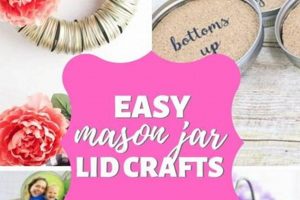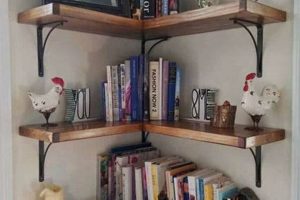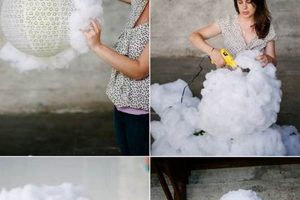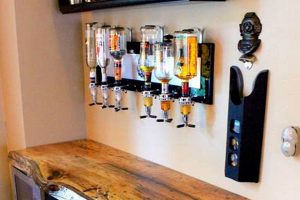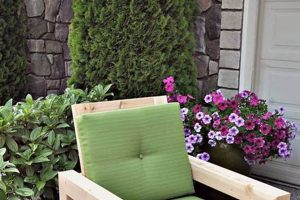The concept encompasses creative projects that repurpose corrugated fiberboard containers into functional or decorative items. These endeavors typically involve cutting, folding, gluing, painting, or otherwise modifying discarded packaging to create new objects. Examples range from simple storage solutions to intricate playhouses and artistic sculptures.
Repurposing materials presents environmental and economic advantages. It reduces waste, minimizes the need for new resource extraction, and provides a cost-effective alternative to purchasing commercially manufactured goods. Historically, adaptive reuse of available materials has been a common practice, reflecting resourcefulness and ingenuity in various cultures.
The following discussion will outline a variety of applications for this type of craft, exploring both practical and imaginative possibilities. These applications range from organizational tools to children’s toys and even home dcor.
Practical Guidance for Repurposing Cardboard Containers
Achieving successful outcomes when transforming corrugated fiberboard containers necessitates careful planning and execution. The following guidelines offer insights into maximizing material usage and project durability.
Tip 1: Selection of Appropriate Materials: Prioritize containers constructed from robust, multi-layered corrugated fiberboard. Thinner, single-layer options are less suitable for projects requiring significant structural integrity. Consider the container’s original contents and avoid boxes that have been exposed to moisture or contaminants.
Tip 2: Precise Measurement and Cutting: Accurate measurements are crucial for achieving desired dimensions and ensuring proper alignment. Utilize a sharp utility knife or box cutter, in conjunction with a straight edge, to create clean, precise cuts. Dull blades can tear the material, resulting in uneven edges and structural weakness.
Tip 3: Reinforcement of Structural Weak Points: Areas subject to stress or weight-bearing should be reinforced using additional cardboard layers, strong adhesives, or fasteners. Consider employing corner bracing to enhance stability, particularly in projects involving shelves or supports.
Tip 4: Secure Adhesion Techniques: Select an adhesive appropriate for bonding corrugated fiberboard, such as hot glue, construction adhesive, or specialized cardboard glue. Ensure thorough and even application to maximize bond strength. Clamping or weighting glued surfaces during the curing process will further improve adhesion.
Tip 5: Protective Finishing: Applying a protective sealant or paint can enhance the durability and appearance of the finished project. Consider using non-toxic, water-resistant coatings, especially for items intended for outdoor use or interaction with children.
Tip 6: Prioritize Safety: When employing cutting tools, exercise caution to prevent injury. Always cut on a protected surface and maintain a firm grip on both the tool and the cardboard. Supervise children closely when they are participating in repurposing activities.
Adhering to these recommendations increases the likelihood of creating durable, aesthetically pleasing, and functional items. Careful material selection, precise execution, and strategic reinforcement contribute significantly to project success.
The next section details specific project ideas, showcasing the diverse applications of this approach to creative reuse.
1. Structure
Structure constitutes a fundamental element in the repurposing of corrugated fiberboard containers. It dictates the load-bearing capacity, stability, and overall integrity of the final product. Structural considerations are paramount to ensure the long-term utility and safety of any project utilizing this material.
- Material Selection and Orientation
The choice of cardboard and its alignment significantly impact structural performance. Multi-layered corrugated board provides greater strength than single-layer options. Orienting the flutes (the wavy inner layer) vertically in load-bearing applications enhances resistance to compression and prevents collapse. Consideration of the cardboard’s original purpose is also essential, avoiding materials previously exposed to excessive moisture or contaminants that might compromise integrity.
- Joint Construction and Reinforcement
The manner in which individual pieces of cardboard are joined profoundly affects the structural soundness of the overall creation. Techniques such as overlapping joints, reinforced corners, and the strategic application of adhesives or fasteners are crucial for distributing stress and preventing failure. Weak points, such as seams and edges, necessitate careful attention and reinforcement to maintain stability under load.
- Geometric Design and Support Systems
The overall geometric design of the project inherently influences its structural capabilities. Triangular and cylindrical forms offer inherent stability and resistance to deformation. Internal supports, such as ribs, gussets, and cross-bracing, provide additional reinforcement, distributing weight and preventing buckling. Consideration of the design’s inherent load paths is crucial for identifying and mitigating potential weak points.
- External Load Distribution and Stability
Ensuring that the structure can withstand the intended external loads is critical. Weight should be evenly distributed to prevent localized stress concentrations that could lead to failure. A stable base and a low center of gravity enhance overall stability, reducing the risk of tipping or collapsing under load. Testing the structure’s capacity under controlled conditions can identify weaknesses and inform necessary modifications.
These structural considerations are inextricably linked to the success of repurposing cardboard. Careful attention to material selection, joint construction, geometric design, and load distribution ensures that the resulting creation is not only aesthetically pleasing but also functionally sound and capable of withstanding intended use.
2. Functionality
Functionality, when considering the repurposing of cardboard containers, constitutes a primary determinant of project success. The correlation between the intended use and the resulting design is crucial. A poorly conceived design, irrespective of its aesthetic merit, compromises the usefulness and practical value of the repurposed item. For example, a cardboard storage box without adequate structural support to hold its intended contents is functionally deficient. The design must therefore precede execution, ensuring alignment with the intended application. This necessitates understanding load-bearing capacities, spatial requirements, and ergonomic considerations, tailoring the project to meet specific needs efficiently.
Specific applications illuminate the importance of aligning design with function. Consider a child’s playhouse constructed from cardboard. Structural integrity, ease of access, and safe interaction are paramount. The dimensions must accommodate the child comfortably, entry and exit points should be readily accessible and free from sharp edges, and the overall structure should be stable enough to withstand active play. Similarly, a cardboard divider designed for office use needs to provide adequate visual and acoustic privacy. Dimensions, material thickness, and assembly method directly impact its efficacy in creating a more focused workspace. These examples underscore how functionality dictates design choices, shaping the project from conception to completion.
In conclusion, functionality is inextricably linked to the success of repurposing cardboard. Prioritizing intended use during the design phase enhances the practical value and extends the lifespan of the project. A holistic understanding of functional requirements, coupled with careful material selection and sound construction techniques, ensures that these repurposed creations are not merely aesthetically pleasing but also useful and enduring.
3. Aesthetics
Aesthetics, in the context of repurposing corrugated fiberboard containers, extends beyond mere visual appeal; it encompasses the overall sensory experience and the perceived value of the finished product. Integrating aesthetic considerations into “diy cardboard box ideas” elevates functional objects into artistic expressions, impacting user perception and the likelihood of continued use. The raw material, typically perceived as disposable, undergoes a transformation, necessitating deliberate attention to surface treatments, color palettes, and overall design coherence.
The implementation of aesthetic principles can significantly influence the perceived value and utility of repurposed items. For instance, a simple cardboard storage box, embellished with carefully chosen paint, decorative paper, or fabric, transitions from a utilitarian object to a visually engaging element within the environment. Similarly, a child’s playhouse, enhanced with vibrant colors, intricate cutouts, and thematic details, transcends its basic structural function, becoming a focal point for imaginative play. These examples highlight the synergistic relationship between functionality and aesthetics, underscoring the importance of considering both aspects throughout the design and construction process.
Challenges in achieving desired aesthetic outcomes often stem from the inherent limitations of the base material. Corrugated fiberboard, while versatile, presents challenges related to texture, durability, and susceptibility to moisture. Addressing these limitations requires the application of appropriate surface treatments, such as sealing, priming, and coating, to create a stable and visually appealing finish. Ultimately, the successful integration of aesthetics into cardboard repurposing projects requires a balance between creative vision, technical skill, and a deep understanding of the material’s properties.
4. Durability
The lifespan of repurposed corrugated fiberboard projects is directly correlated with the implementation of durability-enhancing techniques. Without appropriate considerations, these creations are susceptible to degradation from moisture, stress, and general wear, limiting their long-term utility. Optimizing structural integrity and material resistance is paramount for maximizing the functional lifespan of “diy cardboard box ideas”.
- Material Selection and Preparation
The grade and condition of the cardboard used significantly influence the finished product’s resistance to damage. Heavy-duty, multi-layered corrugated board offers increased strength compared to thinner, single-layer varieties. Prior to construction, inspection for existing damage, such as creases or moisture exposure, is crucial. Pre-treatment with sealants or water-resistant coatings can mitigate the impact of environmental factors, extending the material’s usable life.
- Joint Reinforcement and Fastening Methods
The manner in which individual components are connected directly impacts the overall structural integrity. Simple adhesive bonds may prove insufficient for projects subjected to substantial weight or stress. Reinforcing joints with additional cardboard layers, using mechanical fasteners such as staples or screws (where appropriate), or employing interlocking designs strengthens connections and prevents premature failure. Proper selection of adhesives suited for cardboard bonding is also essential.
- Surface Protection and Finishing
Exposed cardboard surfaces are vulnerable to abrasion, moisture absorption, and degradation from ultraviolet radiation. Applying protective coatings, such as paint, varnish, or laminates, creates a barrier against these elements. The type of coating should be selected based on the intended use of the project, with consideration given to factors such as water resistance, scratch resistance, and UV protection. Regular maintenance and reapplication of protective finishes may be necessary to preserve the integrity of the material over time.
- Design for Load Distribution and Stress Reduction
Structural design plays a critical role in distributing weight and minimizing stress on specific areas. Incorporating support structures, such as ribs, gussets, or internal bracing, enhances the load-bearing capacity of the project and prevents localized failure. Distributing weight evenly and avoiding sharp corners or stress concentrations reduces the risk of deformation or collapse under load. Careful planning and consideration of structural principles are essential for creating durable and long-lasting designs.
These facets underscore the importance of proactive measures to enhance the longevity of creations from cardboard. By carefully selecting materials, reinforcing joints, protecting surfaces, and designing for optimal load distribution, the practical lifespan of “diy cardboard box ideas” can be significantly extended. These considerations transform a temporary material into a more enduring and valuable resource.
5. Sustainability
Sustainability is intrinsically linked to repurposing corrugated fiberboard containers. The practice directly mitigates environmental impact by diverting waste from landfills and reducing the demand for virgin materials. This waste reduction has cascading effects, including decreased energy consumption associated with manufacturing new cardboard, diminished deforestation to produce raw materials, and a reduced carbon footprint from transportation and disposal processes. The utilization of discarded packaging transforms a linear consumption model into a more circular and sustainable system.
The importance of sustainable practices within the context of repurposing corrugated fiberboard is exemplified by community-based initiatives focused on promoting reuse and reducing waste. Educational programs demonstrate techniques for transforming discarded boxes into functional items, raising awareness about waste management and fostering a culture of resourcefulness. Co
mpanies are also exploring innovative approaches, such as designing packaging specifically for secondary uses or partnering with recycling centers to facilitate the collection and redistribution of reusable cardboard. These examples illustrate the tangible benefits of integrating sustainability into repurposing endeavors, fostering environmental responsibility and resource conservation.
Successfully linking sustainability with repurposing efforts requires addressing challenges such as ensuring the cleanliness and suitability of materials, promoting widespread adoption of reuse practices, and developing efficient systems for collecting and distributing discarded containers. Overcoming these obstacles necessitates collaborative efforts between individuals, businesses, and government agencies. By prioritizing sustainable practices, repurposing cardboard containers can evolve from a niche activity into a significant contributor to waste reduction, resource conservation, and a more environmentally responsible future.
6. Accessibility
Accessibility, in the context of repurposing corrugated fiberboard containers, signifies the ease with which individuals, regardless of skill level, physical ability, or economic status, can engage in and benefit from these activities. The inherent simplicity of cardboard, coupled with its widespread availability, positions it as a uniquely accessible material for creative endeavors. Low material costs, minimal tool requirements, and readily available instructions contribute to the democratized nature of such projects.
The importance of accessibility is exemplified in educational and therapeutic settings. Children and individuals with disabilities can manipulate and modify cardboard with relative ease, fostering creativity and self-expression without significant physical or cognitive barriers. The low cost of materials allows for widespread participation in under-resourced communities, providing opportunities for skill development and creative engagement that might otherwise be unattainable. Furthermore, adaptable designs can be tailored to meet specific needs, such as creating assistive devices or adaptive play equipment.
Challenges to accessibility include ensuring clear and inclusive instructions, promoting safe tool use, and addressing potential physical limitations. Providing step-by-step guides with visual aids, offering modifications for individuals with impaired dexterity, and advocating for responsible use of cutting tools mitigate these challenges. Prioritizing accessibility expands the reach and impact of repurposing cardboard, transforming it from a niche activity into a widely accessible and empowering form of creative expression and practical problem-solving.
7. Originality
Originality, within the realm of repurposed corrugated fiberboard projects, transcends mere novelty. It represents the infusion of individual creativity and problem-solving into the transformation of a ubiquitous material. It moves beyond replicating existing designs and emphasizes the development of unique solutions or aesthetic expressions, setting a project apart through distinctive characteristics.
- Conceptual Innovation
Conceptual innovation involves devising novel applications or functions for repurposed cardboard. This might entail designing a storage system that adapts to unconventional spaces, creating a piece of furniture with a previously unseen structural design, or developing a game or toy that leverages the material’s properties in a unique way. For example, an artist might conceive a cardboard-based kinetic sculpture, or an engineer could design a modular disaster relief shelter using interlocking cardboard components. The degree of conceptual innovation directly impacts the project’s uniqueness and potential value.
- Aesthetic Differentiation
Aesthetic differentiation focuses on creating visually distinct and appealing designs through the application of surface treatments, textures, and forms. This can involve incorporating unconventional painting techniques, employing intricate cutting patterns, or integrating found objects to create unexpected visual effects. A cardboard lamp, for instance, could be transformed through the application of decoupage, intricate laser-cut patterns, or the addition of embedded lighting elements. Aesthetic differentiation enhances the project’s artistic merit and its ability to integrate seamlessly into diverse environments.
- Material Exploration and Manipulation
Material exploration involves pushing the boundaries of how corrugated fiberboard is used and manipulated. This can entail experimenting with different layering techniques to achieve specific structural properties, developing novel methods for bending or shaping the material, or combining cardboard with other materials in unexpected ways. For instance, a designer might explore the use of folded cardboard to create self-supporting structures, or combine cardboard with resin to achieve waterproof and durable surfaces. Material exploration expands the potential applications of repurposed cardboard and can lead to innovative structural and functional solutions.
- Adaptive Reuse and Contextual Relevance
Adaptive reuse focuses on tailoring repurposed cardboard projects to specific contexts or needs. This can involve designing solutions that address local environmental challenges, creating items that reflect cultural traditions, or adapting existing designs to accommodate specific physical limitations. A community group, for example, might create cardboard-based planters for urban gardening initiatives, or develop assistive devices for individuals with mobility impairments. Adaptive reuse enhances the project’s relevance and value by addressing specific needs and contributing to community well-being.
These facets, when combined, underscore the importance of originality in repurposing corrugated fiberboard. Moving beyond simple replication and embracing innovative concepts, aesthetic differentiation, material exploration, and adaptive reuse elevates these “diy cardboard box ideas” from mundane crafts to valuable expressions of creativity, problem-solving, and contextual relevance.
Frequently Asked Questions
The following addresses common inquiries regarding the process and outcomes associated with repurposing corrugated fiberboard containers.
Question 1: What types of cardboard are best suited for repurposing?
Multi-layered corrugated cardboard offers superior structural integrity compared to single-layer options. Prioritize boxes in good condition, free from excessive moisture, damage, or contamination.
Question 2: What tools are essential for engaging in these projects?
A sharp utility knife or box cutter, a straight edge or ruler, a cutting surface, appropriate adhesives, and safety glasses are fundamental. Additional tools, such as saws, drills, or paintbrushes, may be required depending on the project’s complexity.
Question 3: How can the structural integrity of cardboard creations be improved?
Reinforcing joints with additional cardboard layers, employing adhesives designed for cardboard bonding, and incorporating internal supports or bracing enhance structural stability.
Question 4: What are effective methods for protecting cardboard from moisture?
Applying sealants, paints, or laminates creates a protective barrier against moisture absorption. Selecting water-resistant coatings and ensuring thorough surface coverage are crucial.
Question 5: How can the aesthetic appeal of repurposed cardboard items be enhanced?
Employing decorative paints, papers, fabrics, or other embellishments adds visual interest. Careful attention to color palettes, surface textures, and overall design coherence contributes to an aesthetically pleasing result.
Question 6: Are there any safety precautions to consider when working with cardboard and related tools?
Exercise caution when using cutting tools to prevent injury. Always cut on a protected surface, maintain a firm grip, and supervise children closely. Wear safety glasses to protect against debris.
The preceding answers provide guidance for addressing fundamental concerns related to the process. Careful planning and execution are essential for successful outcomes.
The subsequent section explores advanced techniques and project ideas, offering inspiration and guidance for more complex repurposing endeavors.
Conclusion
This exploration of “diy cardboard box ideas” has underscored the potential of transforming discarded corrugated fiberboard containers into functional and aesthetically pleasing items. Emphasis has been placed on structural integrity, functional design, aesthetic considerations, durability enhancements, and sustainable practices. The multifaceted nature of these activities demonstrates their capacity to address practical needs, foster creative expression, and contribute to environmental responsibility.
The ongoing need for resourcefulness and waste reduction suggests a continued relevance for these practices. Further investigation into innovative techniques and collaborative initiatives may unlock even greater potential for transforming readily available materials into valuable resources, promoting both individual ingenuity and collective sustainability efforts.


